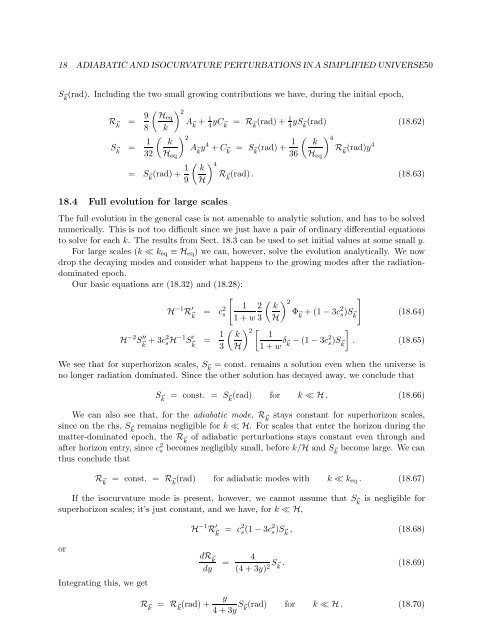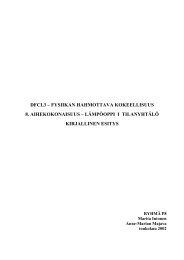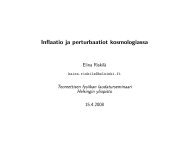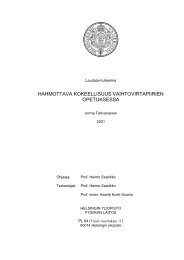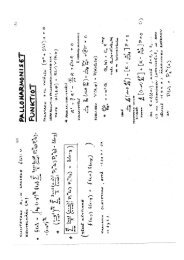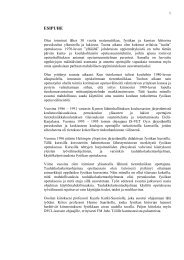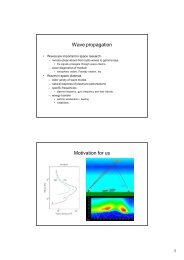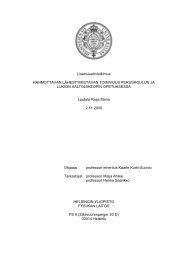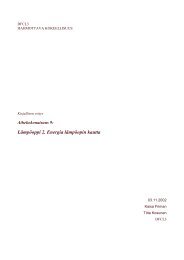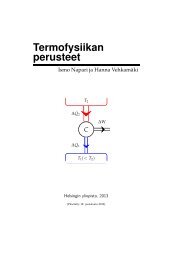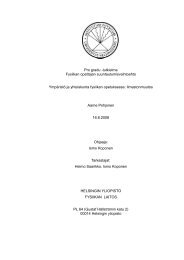Cosmological Perturbation Theory, 26.4.2011 version
Cosmological Perturbation Theory, 26.4.2011 version
Cosmological Perturbation Theory, 26.4.2011 version
You also want an ePaper? Increase the reach of your titles
YUMPU automatically turns print PDFs into web optimized ePapers that Google loves.
18 ADIABATIC AND ISOCURVATURE PERTURBATIONS IN A SIMPLIFIED UNIVERSE50S ⃗k (rad). Including the two small growing contributions we have, during the initial epoch,R ⃗k = 9 ( ) 2 HeqA ⃗k + 18 k4 yC ⃗ k= R ⃗k (rad) + 1 4 yS ⃗ k(rad) (18.62)S ⃗k = 1 ( ) k 2A ⃗k y 4 + C ⃗k = S ⃗k (rad) + 1 ( ) k 4R ⃗k (rad)y 432 H eq 36 H eq= S ⃗k (rad) + 1 9( kH) 4R ⃗k (rad). (18.63)18.4 Full evolution for large scalesThe full evolution in the general case is not amenable to analytic solution, and has to be solvednumerically. This is not too difficult since we just have a pair of ordinary differential equationsto solve for each k. The results from Sect. 18.3 can be used to set initial values at some small y.For large scales (k ≪ k eq ≡ H eq ) we can, however, solve the evolution analytically. We nowdrop the decaying modes and consider what happens to the growing modes after the radiationdominatedepoch.Our basic equations are (18.32) and (18.28):[ ( ) ]H −1 R ⃗ ′ k= c 2 1 2 k 2sΦ ⃗k + (1 − 3c 2 s1 + w 3 H)S ⃗ k(18.64)H −2 S ⃗ ′′k+ 3c 2 s H−1 S ⃗ ′ k= 1 ( k 2 []13 H)1 + w δ ⃗ k− (1 − 3c 2 s )S ⃗ k. (18.65)We see that for superhorizon scales, S ⃗k = const. remains a solution even when the universe isno longer radiation dominated. Since the other solution has decayed away, we conclude thatS ⃗k = const. = S ⃗k (rad) for k ≪ H . (18.66)We can also see that, for the adiabatic mode, R ⃗k stays constant for superhorizon scales,since on the rhs, S ⃗k remains negligible for k ≪ H. For scales that enter the horizon during thematter-dominated epoch, the R ⃗k of adiabatic perturbations stays constant even through andafter horizon entry, since c 2 s becomes negligibly small, before k/H and S ⃗k become large. We canthus conclude thatR ⃗k = const. = R ⃗k (rad) for adiabatic modes with k ≪ k eq . (18.67)If the isocurvature mode is present, however, we cannot assume that S ⃗k is negligible forsuperhorizon scales; it’s just constant, and we have, for k ≪ H,orIntegrating this, we getH −1 R ′ ⃗ k= c 2 s (1 − 3c2 s )S ⃗ k, (18.68)dR ⃗kdyR ⃗k = R ⃗k (rad) +=4(4 + 3y) 2S ⃗ k. (18.69)y4 + 3y S ⃗ k(rad) for k ≪ H . (18.70)


